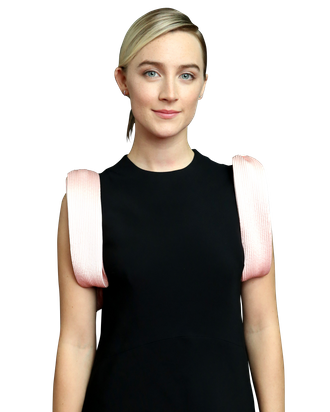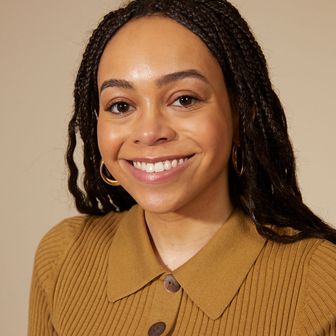
By the time Mary Stuart and Elizabeth I come face-to-face in Mary Queen of Scots, it’s a meeting more fraught than the big showdown in Heat. There’s a different desperation, a feeling of defeat: Saoirse Ronan plays the titular role, with Margot Robbie playing Elizabeth. The women have spent years competing, corresponding, scheming, and (occasionally) compromising, until Mary has played her last cards. The men in her corner have been busy backstabbing and back-channeling, and it seems that the woman she’s trying to replace is the only one that could save her.
“I was really emotional doing it,” Ronan told Vulture about the scene. During production on Mary Queen of Scots, she and Robbie intentionally kept their distance. Their one scene together even has a delayed reveal, with the women pacing around a cabin lined with white sheets. “For the first half of the scene, we didn’t see each other. The cameras were set up to shoot our close-ups simultaneously, as they pulled down the sheets and we saw each other for the first time. It was really emotional. We were, like, shaking. The adrenaline of that, I think, really got to us in that first take.”
Mary ultimately loses out on her bid to the throne, eventually being beheaded for allegedly plotting to assassinate Elizabeth. But she’s just as determined and forthright as so many of Ronan’s other characters. “I think there’s been a lot of characters I’ve played that have sort of been out on their own a little bit, sort of separate from either their onlookers or leaders,” Ronan says, when I ask her about a possible through line. “That isn’t necessarily something that I always wanna play, but I have noticed that I’ve done quite a few of those.”
A character in this movie describes Mary as “formidable.” I wanted to hear how you would describe her.
Yeah, she is. She’s certainly formidable, more than anything, when she’s in public and when she’s dealing with her councillors and the court. I think she’s got a lot of strong will. She came from a family of very, very fiery, passionate Scottish and French people. That tenacity is in her blood.
But I do think, as well, she makes mistakes. She has doubts and does second-guess herself sometimes. It was important to humanize her, and not have her just be this very fair, strong figurehead. Because that’s just not real. It was really important to show those moments of doubt as well.
How much did you consider the modern parallels of this story? I mean, Mary is being slut-shamed for trying to consolidate her own power.
I think it’s just that whole issue that we’re dealing with now with “fake news” and stories being warped in order to suit one political side or the other. That’s exactly what happens in Mary’s case.
We sort of mention it at the end of the movie, but the Casket letters that eventually lead to Mary’s death were essentially copied and edited by William Cecil, whom Guy Pearce plays. He just had it out for Mary from the very beginning and really hated her, and would stop at nothing to destroy her. And he actually did: He took private letters that she had sent to a personal friend of hers and confidantes, and he changed them. He actually edited the letters and made it seem as though she was plotting to kill Elizabeth while she was under house arrest. That’s the kind of barbarity that we’re experiencing right now, especially in the U.S.
I know that you and Margot decided to stay separate during filming, but when was the first time you met? Was it on the awards circuit?
It was a few years ago, actually. I was in New York, doing The Crucible, and our mutual friends Richard Curtis and Emma Freud were there at the time. They are pros at throwing dinner parties — they always get lovely, interesting people to come to their house for dinner.
They asked me to come over, and it was actually the first night that I met their daughter, who ended up becoming one of my best friends. But Margot was also there. Straight away, I knew how lovely she was, but I kind of wasn’t surprised because she came off as a very warm, down-to-earth person anyway. She just confirmed that when we got to hang out with each other. We saw each other again at the Oscars a few months after that, and then it was about a year-and-a-half later that we did the film together.
Was there ever a temptation to ask what was going on in her scenes?
Oh, yeah, definitely. But I think that was the point: It needed to feel like I was sort of desperate to see what was going on on the other side. But it was important to stay away from that. I had never experimented in that way before, by staying away from the other actor, and not being involved in what they were doing. I’ve just always sort of believed, Oh, well, you can just act it. But in this case, it only added to the scene that we did finally have together. It gave the film so much anticipation and excitement. It ended up just being this really emotional thing to shoot because we had literally spent a month apart.
Do you think that Mary resents Elizabeth? Do you think it’s harder to take a throne than to keep one?
No, I think it’s probably harder to keep one. In this case, it became quite complicated. I don’t think Mary resented Elizabeth because Mary truly believes — and I believe as well — that she was the rightful heir to the throne. She had a purer bloodline than Elizabeth did, and she wasn’t born out of wedlock, or anything like that.
I think she was able to be as forthright and resolute as she was because she really did believe that the crown and the throne belonged to her. What the film shows, in my thinking, is that unfortunately — especially for a woman — you did have to either relinquish the crown to become a mother and a wife and all of the other things that you wanted to be personally. Or you abandoned all of those wants and needs and became a very cold, isolated person who ends up ruling for 40 years, or however long it was that Elizabeth ruled for. Elizabeth was the longest-reigning monarch, but there was an awful lot that she missed out on.
There’s a great proposal scene in this, between you and Jack Lowden. Is it very hard to flirt while on horseback?
No, it wasn’t at all. It was such a romantic setting. We were on the crest of the hill, and both Jack and I loved riding horses anyway. He had done it before; I hadn’t. But we both really enjoyed that and really loved doing it while we were making the film. I think we were just so excited that we got to actually do it in the scene. And, if anything, when you’re having to focus on something physical like riding a horse, it adds to the thing that you’re doing. It gets you out of your head a little bit and makes everything a bit more immediate.
Mary was surrounded by men who tried to either outsmart her or undermine her. Watching this felt like a lesson that men are incompetent and marriage is kind of a trap.
You know, not all men are incompetent — certainly some of the men in this are. It’s just a really tragic thing. There are so many of them that were close to her that betrayed here. They got sort of drunk on power and were so desperate for her, which was really the case in the U.K. and up in Scotland — there were so many lords that moved from one side to the other based on what they could get out of it, out of that alliance. Their alliances were shifting all the time, and I think Mary’s was so true to what she believed in and the people she was close to. And to have that taken for granted was pretty tragic.
The last shot of this felt like the final shot of Lady Bird: Both characters let out an exhale after a very emotionally charged scene. Did you notice that?
I might have, yeah.
I’m so struck by the way you’re able to channel such passionate and desirous characters, especially in these intense scenes. The last scene of Mary is her walking to be executed. Where do you think that comes from?
I think you just said it there, the fact that they’re intense scenes. That sort of brings all of those emotions out in you. It gives you license to feel ferocious or frustrated or emotional. And it’s just sort of about allowing yourself to open up to the scene that you’re in. And once you do that, that will allow you to access any emotion, really, that feels right for the scene and feel, sort of, appropriate for the scene. I love doing that stuff, and I loved that I got to do it with Mary. It’s empowering, getting to play someone who does have this mixed bag of emotions.
You started acting when you were really young. Has your relationship to your work and how you work changed as you’ve gotten older?
In essence, no. The reason why I love it is still the same. When I started out, I was a kid and certainly drawing from life experience or anything like that. Whereas, now, that just sort of naturally happens more and more. It does become a much more personal thing when you’re creating a role.
But just the more you do it, the more risk-taking you do. From one film to the next, you kind of settle into it a little bit more and are willing to try different things that maybe you wouldn’t have been as brave to do a few years ago. I definitely am feeling that at the minute because I’m stepping out of my comfort zone a bit with the job I’m doing right now.
Is that Little Women? Can you tell me what it was like to reunite with Timmy and Greta?
It’s been great. It’s so nice to just be working with people that you know already and who you get along with, and you know how they work. And that’s the thing, I think, because we all know each other so well, and we know how the other one works so well, where the three of us are really taking risks with it and really kinda pushing ourselves. We just feel like we’re really in a safe space. So, yeah, it’s been amazing.


